





Tour To Fiji


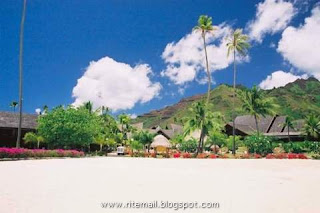 Fiji consists of 322 islands, of which about one third are inhabited. The two most important islands are Viti Levu and Vanua Levu. Viti Levu hosts the capital city of Suva, and is home to nearly three quarters of the population. The islands are mountainous, with peaks up to 1200 m, and covered with tropical forests. Other important towns include Nadi, (location of the international airport) as well as Labasa, Lautoka, and Savusavu. Other islands and island groups include Taveuni and Kadavu (the third and fourth largest islands respectively, the Mamanuca Group (just outside Nadi) and Yasawa Group, which are popular tourist destinations, the Lomaiviti Group, outside of Suva, and the remote Lau Group.
Fiji consists of 322 islands, of which about one third are inhabited. The two most important islands are Viti Levu and Vanua Levu. Viti Levu hosts the capital city of Suva, and is home to nearly three quarters of the population. The islands are mountainous, with peaks up to 1200 m, and covered with tropical forests. Other important towns include Nadi, (location of the international airport) as well as Labasa, Lautoka, and Savusavu. Other islands and island groups include Taveuni and Kadavu (the third and fourth largest islands respectively, the Mamanuca Group (just outside Nadi) and Yasawa Group, which are popular tourist destinations, the Lomaiviti Group, outside of Suva, and the remote Lau Group.Labels: Island



 People amaze and amuse me. It is a wonderment that never ceases. Often times it can be appalling, the brutal and insensitive nature of humanity, but for the most part, I've always found it inspiring. Man is capable of the grandest achievements - philosophically, artistically, and mechincally - and yet, simultaneously, can be reduced to tearful, hysterical laughter by a really good fart joke. It is this duality of the human spirit that moves me; the sacred and the profane, the high-brow and the low-brow, the earnest endeavor and the flight of fancy.There is a tree at the Kings Island amusement park in Ohio. I forget which ride it is, one of the big water rides. The line you have to stand in winds through a forest to the attraction. There are many trees along the path, but one in particular was singled out by the throngs of hot, idle park-goers for a piece of impromptu collective art. I've always called it the gum tree. There, on the right-side of the path stands the small tree, it's trunk almost completely covered in globs of chewing gum of every color imaginable. It's not like base graffiti, an essentially one person show of artistry on a public canvas. Sure, graffiti when un-checked results in a collection of various artists in a localized area, but it's not a collective effort on a singular undertaking. Someone, most likely a group of someones, standing in that line decided to all stick their gum on that tree. Consequentially, over the years, more and more people added more gum to the tree, resulting in the myriad of color that exists today.I discovered a similar phenomena in central Nevada. Trees are rare here in the desert climate. One is generally hard pressed to spot a tree on the stark landscape. U.S. Highway 50 runs laterally through the center of the state, from Ely on its eastern border all the way to Lake Tahoe. It is a beautful drive, with long stretches of open country. Often times you can drive anywhere from 50 to 100 miles between towns with nary a house in site. Between the small towns of Fallon and Austin stands a tree on the side of the highway. Much like the gum tree in Ohio, it has become a living, breathing work of collective art - a piece which has an unwritten history and a fluid, unending future. It exists by the sheer will of its anonymous participants and the spirit of conspiracy. I present to you, in all its breathtaking majesty and glory, the Nevada shoe tree.
People amaze and amuse me. It is a wonderment that never ceases. Often times it can be appalling, the brutal and insensitive nature of humanity, but for the most part, I've always found it inspiring. Man is capable of the grandest achievements - philosophically, artistically, and mechincally - and yet, simultaneously, can be reduced to tearful, hysterical laughter by a really good fart joke. It is this duality of the human spirit that moves me; the sacred and the profane, the high-brow and the low-brow, the earnest endeavor and the flight of fancy.There is a tree at the Kings Island amusement park in Ohio. I forget which ride it is, one of the big water rides. The line you have to stand in winds through a forest to the attraction. There are many trees along the path, but one in particular was singled out by the throngs of hot, idle park-goers for a piece of impromptu collective art. I've always called it the gum tree. There, on the right-side of the path stands the small tree, it's trunk almost completely covered in globs of chewing gum of every color imaginable. It's not like base graffiti, an essentially one person show of artistry on a public canvas. Sure, graffiti when un-checked results in a collection of various artists in a localized area, but it's not a collective effort on a singular undertaking. Someone, most likely a group of someones, standing in that line decided to all stick their gum on that tree. Consequentially, over the years, more and more people added more gum to the tree, resulting in the myriad of color that exists today.I discovered a similar phenomena in central Nevada. Trees are rare here in the desert climate. One is generally hard pressed to spot a tree on the stark landscape. U.S. Highway 50 runs laterally through the center of the state, from Ely on its eastern border all the way to Lake Tahoe. It is a beautful drive, with long stretches of open country. Often times you can drive anywhere from 50 to 100 miles between towns with nary a house in site. Between the small towns of Fallon and Austin stands a tree on the side of the highway. Much like the gum tree in Ohio, it has become a living, breathing work of collective art - a piece which has an unwritten history and a fluid, unending future. It exists by the sheer will of its anonymous participants and the spirit of conspiracy. I present to you, in all its breathtaking majesty and glory, the Nevada shoe tree.
 While I'm sure no one went barefoot to create this masterpiece, it is arguable that it has required a bit of sacrifice to create and forethought to maintain. Whoever began this must've had some extra shoes and just tossed them into the tree branches. Over the years, people travelling through the area have made their donation to the tree with pairs of unwanted shoes that happened to be in their RV's and trucks.
While I'm sure no one went barefoot to create this masterpiece, it is arguable that it has required a bit of sacrifice to create and forethought to maintain. Whoever began this must've had some extra shoes and just tossed them into the tree branches. Over the years, people travelling through the area have made their donation to the tree with pairs of unwanted shoes that happened to be in their RV's and trucks. It is an amazing sight up close. The tree is filled with every type and size shoe imaginable. Children's sneakers and adult's atheletic shoes. Boots of all stripes: workboots, hiking boots, cowboy boots, and even a pair of rubber knee-high "hipwaders". Pumps, sandals, wing-tips, and loafers.
It is an amazing sight up close. The tree is filled with every type and size shoe imaginable. Children's sneakers and adult's atheletic shoes. Boots of all stripes: workboots, hiking boots, cowboy boots, and even a pair of rubber knee-high "hipwaders". Pumps, sandals, wing-tips, and loafers. Which is what makes this project so astounding on a level that the gum tree cannot begin to approach. This tree, literally and figuratively, represents every walk of American life. What probably began as a prank or a joke, and is probably still fueled largely by mischeivous adolescents, has blossmed into a beautiful statement which an indivudal artist could never capture. The very essence of the art lies in the fact that it was created in cohort and by collusion to create an unintentional statement.
Which is what makes this project so astounding on a level that the gum tree cannot begin to approach. This tree, literally and figuratively, represents every walk of American life. What probably began as a prank or a joke, and is probably still fueled largely by mischeivous adolescents, has blossmed into a beautiful statement which an indivudal artist could never capture. The very essence of the art lies in the fact that it was created in cohort and by collusion to create an unintentional statement. It is certainly one of the most amazing things I have seen in my great American escapade thus far. For me it captures perfectly that dual nature of humanity, particularly the American human. Sometimes it is easy to feel inconsequential, like one's contribution to life and society is of little import. In a grander scheme of things, this may be true, but in the realm of the trivial interactions of humans, sometimes all it takes to be part of something beautiful and infamous is tossing a pair of shoes into a tree.
It is certainly one of the most amazing things I have seen in my great American escapade thus far. For me it captures perfectly that dual nature of humanity, particularly the American human. Sometimes it is easy to feel inconsequential, like one's contribution to life and society is of little import. In a grander scheme of things, this may be true, but in the realm of the trivial interactions of humans, sometimes all it takes to be part of something beautiful and infamous is tossing a pair of shoes into a tree.

Labels: Nevada Shoe Tree
 The the worlds newest tallest building is about to be completed, lookx amazing, should be safer than going to space to get a better view of Earth.
The the worlds newest tallest building is about to be completed, lookx amazing, should be safer than going to space to get a better view of Earth.
SPECIFICATIONS - BURJ DUBAI (DUBAI TOWER) AND DUBAI MALL, UNITED ARAB EMIRATES
Key Data
Order year : 2003
Construction start : 2004
Project type : Mall, residential and retail facilities and world's tallest skyscraper
Location : Dubai, United Arab Emirates
Estimated investment : Dh800 million (mall, residential and retail facilities); Dh3.9 billion (tower)
Completion 2006 (mall); 2007 (tower)
Retail space : 5 million square ft²Shops : 1,000
Car parking : 16,000 spaces Key Players
Sponsor : EMAAR Properties PJSC
Lead contractors, designers, architects and engineers : DC Architects PTE Limited, Skidmore, Owings and Merrill, Bauer Spezialtiefbau, Middle East Foundations, Turner Construction Corporation, Grocon, Lerch, Bates and Associates Incorporated
 This image is from BBC comparing the biggest buildings. You can't say they don't have a vision. Remarkably, the inspiration for the tower comes from - a flower. The Hymenocallis is a plant widely cultivated in Dubai , India and around the region. It's harmonious structure is one of the organizing principles for the design.
This image is from BBC comparing the biggest buildings. You can't say they don't have a vision. Remarkably, the inspiration for the tower comes from - a flower. The Hymenocallis is a plant widely cultivated in Dubai , India and around the region. It's harmonious structure is one of the organizing principles for the design.
Labels: World's Tallest Tower
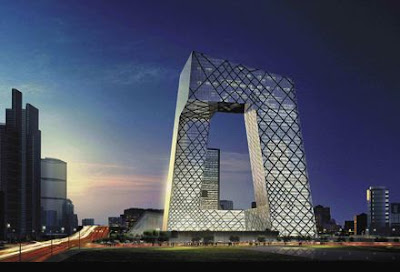 China 's current building boom is doing more than sucking up the world's supply of steel -- it's creating a stage for some of today's boldest architecture and engineering. Take a tour of the 10 of the most intriguing examples.
China 's current building boom is doing more than sucking up the world's supply of steel -- it's creating a stage for some of today's boldest architecture and engineering. Take a tour of the 10 of the most intriguing examples.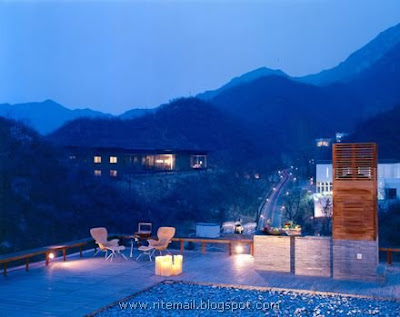 China 's current building boom is doing more than sucking up the world's supply of steel -- it's creating a stage for some of today's boldest architecture and engineering. Take a tour of the 10 of the most intriguing examples.
China 's current building boom is doing more than sucking up the world's supply of steel -- it's creating a stage for some of today's boldest architecture and engineering. Take a tour of the 10 of the most intriguing examples.  According to the U.S. Embassy to China, the country will be building 108 new airports between 2004 and 2009 -- including what will be the world's largest: the Beijing International Airport, designed by Foster & Partners. Set to open at the end of 2007, in time for the Beijing Olympics in 2008, the airport terminal will cover more than 1 million square meters, giving it a bigger footprint than the Pentagon.
According to the U.S. Embassy to China, the country will be building 108 new airports between 2004 and 2009 -- including what will be the world's largest: the Beijing International Airport, designed by Foster & Partners. Set to open at the end of 2007, in time for the Beijing Olympics in 2008, the airport terminal will cover more than 1 million square meters, giving it a bigger footprint than the Pentagon.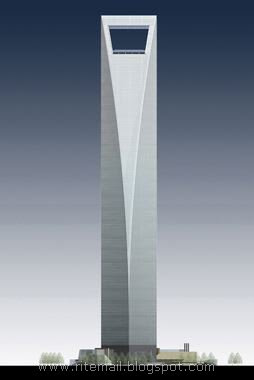 Rising in the Lujiazhui financial district in Pudong, the Shanghai World Financial Center is a tower among towers. The elegant 101-story skyscraper will be (for a moment, at least) the world's tallest when completed in early 2008.
Rising in the Lujiazhui financial district in Pudong, the Shanghai World Financial Center is a tower among towers. The elegant 101-story skyscraper will be (for a moment, at least) the world's tallest when completed in early 2008.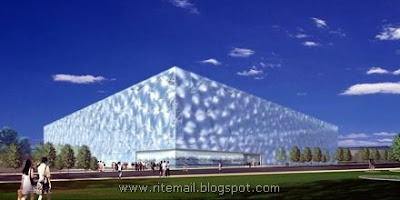 The striking exterior of the National Swimming Center , being constructed for the 2008 Olympic Games and nicknamed, the "Water Cube," is made from panels of a lightweight form of Teflon that transforms the building into an energy-efficient greenhouse-like environment. Solar energy will also be used to heat the swimming pools, which are designed to reuse double-filtered, backwashed pool water that's usually dumped as waste.
The striking exterior of the National Swimming Center , being constructed for the 2008 Olympic Games and nicknamed, the "Water Cube," is made from panels of a lightweight form of Teflon that transforms the building into an energy-efficient greenhouse-like environment. Solar energy will also be used to heat the swimming pools, which are designed to reuse double-filtered, backwashed pool water that's usually dumped as waste.
Excess rainwater will also be collected and stored in subterranean tanks and used to fill the pools. The complex engineering system of curvy steel frames that form the structure of the bubble-like skin are based on research into the structural properties of soap bubbles by two physicists at Dublin 's Trinity College . The unique structure is designed to help the building withstand nearly any seismic disruptions.
5. Central Chinese Television CCTV, Beijing OMA/Ole Scheeren and Rem Koolhaas. Under construction, scheduled for completion in 2008
 The design of the new Central Chinese Television (CCTV) headquarters defies the popular conception of a skyscraper -- and it broke Beijing's building codes and required approval by a special review panel. The standard systems for engineering gravity and lateral loads in buildings didn't apply to the CCTV building, which is formed by two leaning towers, each bent 90 degrees at the top and bottom to form a continuous loop.
The design of the new Central Chinese Television (CCTV) headquarters defies the popular conception of a skyscraper -- and it broke Beijing's building codes and required approval by a special review panel. The standard systems for engineering gravity and lateral loads in buildings didn't apply to the CCTV building, which is formed by two leaning towers, each bent 90 degrees at the top and bottom to form a continuous loop.
The engineer's solution is to create a structural "tube" of diagonal supports. The irregular pattern of this "diagrid" system reflects the distribution of forces across the tube's surface. Designed by Rem Koolhaas and Ole Scheeren and engineered by Ove Arup, the new CCTV tower rethinks what a skyscraper can be.
6. Linked Hybrid, Beijing Steven Holl Architects; Li Hu, lead architect. Groundbreaking on December 28, 2005 , scheduled for completion in 2008
 Linked Hybrid, which will house 2,500 people in 700 apartments covering 1.6 million square feet, is a model for large-scale sustainable residential architecture. The site will feature one of the world's largest geothermal cooling and heating systems, which will stabilize the temperature within the complex of eight buildings, all linked at the 20th floor by a "ring" of service establishments, like cafés and dry cleaners. A set of dual pipes pumps water from 100 meters below ground, circulating the liquid between the buildings' concrete floors.
Linked Hybrid, which will house 2,500 people in 700 apartments covering 1.6 million square feet, is a model for large-scale sustainable residential architecture. The site will feature one of the world's largest geothermal cooling and heating systems, which will stabilize the temperature within the complex of eight buildings, all linked at the 20th floor by a "ring" of service establishments, like cafés and dry cleaners. A set of dual pipes pumps water from 100 meters below ground, circulating the liquid between the buildings' concrete floors. Developed by the Shanghai Industrial investment Corp., Dongtan Eco City , roughly the size of Manhattan , will be the world's first fully sustainable cosmopolis when completed in 2040. Like Manhattan , it's situated on an island -- the third-largest in China . Located on the Yangtze River, Dongtan is within close proximity of the bustle of Shanghai .
Developed by the Shanghai Industrial investment Corp., Dongtan Eco City , roughly the size of Manhattan , will be the world's first fully sustainable cosmopolis when completed in 2040. Like Manhattan , it's situated on an island -- the third-largest in China . Located on the Yangtze River, Dongtan is within close proximity of the bustle of Shanghai .
By the time the Shanghai Expo trade fair opens in 2010, the city's first phase should be completed, and 50,000 residents will call Dongtan home-sweet-sustainable-home. The goals to be accomplished in the next five years: systems for water purification, waste management, and renewable energy. An infrastructure of roads will connect the former agricultural land with Shanghai .
8. Olympic Stadium, Beijing Herzog & de Meuron. Under construction, to be completed in 2008
 Sports stadiums have long followed the enduring design of one of the original wonders of the world, Rome 's Coliseum. Herzog & de Meuron's National Stadium in Beijing is an attempt to rethink the classic sports-arena layout for more ecologically correct times.
Sports stadiums have long followed the enduring design of one of the original wonders of the world, Rome 's Coliseum. Herzog & de Meuron's National Stadium in Beijing is an attempt to rethink the classic sports-arena layout for more ecologically correct times.
The Swiss architects (of Tate Modern fame) wanted to provide natural ventilation for the 91,000-seat structure -- perhaps the largest "eco-friendly" sports stadium designed to date. To achieve this, they set out to create a building that could function without a strictly enclosed shell, yet also provide constant shelter for the audience and athletes alike.
To solve these design problems, they looked to nature for inspiration. The stadium's outer grid resembles a bird's nest constructed of delicately placed branches and twigs. Each discrete space within the facility, from restrooms to restaurants, is constructed as an independent unit within the outer lattice -- making it possible to encase the entire complex with an open grid that allows for natural air circulation. The architects also incorporated a layer of translucent membrane to fill any gaps in the lacy exterior.
9. Donghai Bridge , Shanghai/Yangshan Island China Zhongtie Major Bridge Engineering Group, Shanghai # 2 Engineering Co., Shanghai Urban Construction Group. Officially opened in December, 2005
 A key phase in the development of the world's largest deep-sea port was completed when China 's first cross-sea bridge -- the 20-mile, six-lane DonghaiBridge -- was officially opened in December, 2005. Stretching across the East China Sea , the graceful cable-stay structure connects Shanghai to Yangshan Island , set to become China 's first free-trade port (and the world's largest container port) upon its completion in 2010.
A key phase in the development of the world's largest deep-sea port was completed when China 's first cross-sea bridge -- the 20-mile, six-lane DonghaiBridge -- was officially opened in December, 2005. Stretching across the East China Sea , the graceful cable-stay structure connects Shanghai to Yangshan Island , set to become China 's first free-trade port (and the world's largest container port) upon its completion in 2010.10. National Grand Theater, Beijing Paul Andreu and ADP. Under construction, to be completed in 2008
 Located near Tiananmen Square , the 490,485-square-foot glass-and-titanium National Grand Theater, scheduled to open in 2008, seems to float above a man-made lake. Intended to stand out amid the Chinese capital's bustling streets and ancient buildings, the structure has garnered criticism among Bejing's citizens for clashing with classic landmarks like the Monument to the People's Heroes (dedicated to revolutionary martyrs), the vast home of the National People's Congress, or Tiananmen Gate itself (the Gate of Heavenly Peace).
Located near Tiananmen Square , the 490,485-square-foot glass-and-titanium National Grand Theater, scheduled to open in 2008, seems to float above a man-made lake. Intended to stand out amid the Chinese capital's bustling streets and ancient buildings, the structure has garnered criticism among Bejing's citizens for clashing with classic landmarks like the Monument to the People's Heroes (dedicated to revolutionary martyrs), the vast home of the National People's Congress, or Tiananmen Gate itself (the Gate of Heavenly Peace).
French architect Paul Andreu is no stranger to controversy -- or to innovative forms. A generation ago, in 1974, his untraditional design for Terminal 1 of Paris 's Charles de Gaulle airport was criticized for its unusual curves, yet Andreu's groundbreaking, futuristic building later was seen to distinguish de Gaulle from more generic European and international air hubs. (The same airport's Terminal 2E, also designed by Andreu, gained attention in 2004 when it collapsed, tragically killing four people.)
Beijing 's daring National Grand Theater is as much a spectacle as the productions that will be staged inside in the 2,416-seat opera house, the 2,017-seat concert hall, and the 1,040-seat theater. At night, the semi-transparent skin will give passersby a glimpse at the performance inside one of three auditoriums, a feature that highlights the building's public nature.
Labels: Building

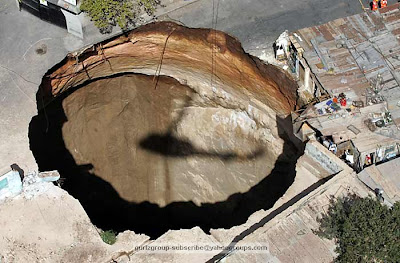
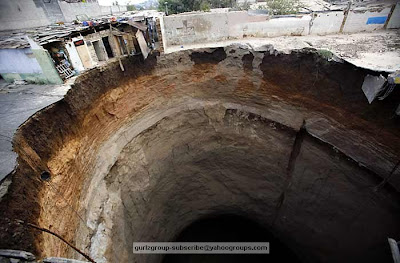
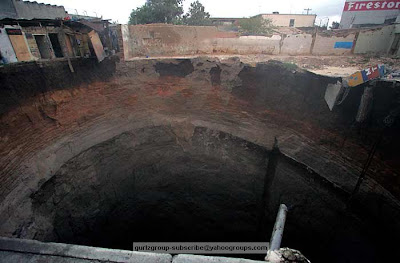
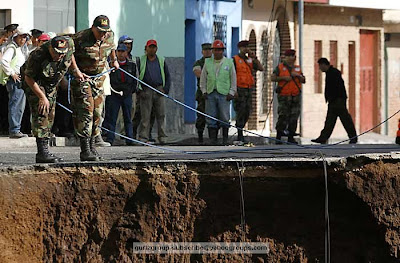 GUATEMALA CITY , Guatemala - killed at least two teenagers as it swallowed about a dozen homes on Friday and forced the evacuation of nearly 1,000 people in a crowded Guatemala City neighborhood. Officials blamed the sinkhole on recent rains and an underground sewage flow from a ruptured main. The pit emitted foul odors, loud noises and tremors, shaking the surrounding ground. A rush of water could be heard from its depths, and authorities feared it could widen or others could open up. Rescue operations were on hold until a firefighter, suspended from a cable, could take video and photos above the hole and officials could use the documentation to decide how to proceed. The dead were identified as Irma and David Soyos, emergency spokesman Juan Carlos Bolanos said. Their bodies were found near the sinkhole, floating in a river of sewage. Their father, Domingo, was still missing, according to disaster coordinator Hugo Hernandez.
GUATEMALA CITY , Guatemala - killed at least two teenagers as it swallowed about a dozen homes on Friday and forced the evacuation of nearly 1,000 people in a crowded Guatemala City neighborhood. Officials blamed the sinkhole on recent rains and an underground sewage flow from a ruptured main. The pit emitted foul odors, loud noises and tremors, shaking the surrounding ground. A rush of water could be heard from its depths, and authorities feared it could widen or others could open up. Rescue operations were on hold until a firefighter, suspended from a cable, could take video and photos above the hole and officials could use the documentation to decide how to proceed. The dead were identified as Irma and David Soyos, emergency spokesman Juan Carlos Bolanos said. Their bodies were found near the sinkhole, floating in a river of sewage. Their father, Domingo, was still missing, according to disaster coordinator Hugo Hernandez.
Labels: Guatemala City : Sinkhole
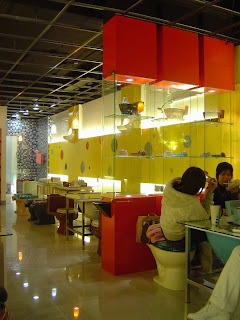


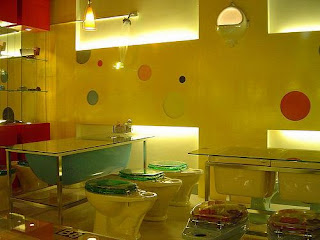
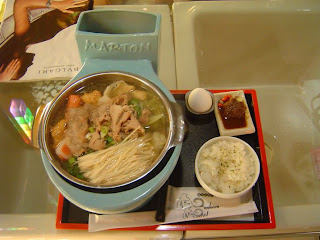
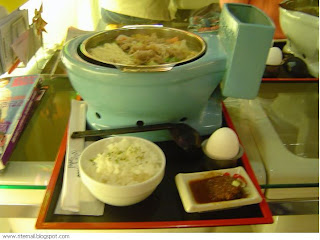
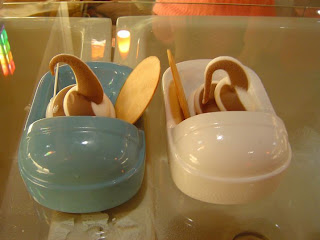
Labels: Toilet Bowl Restaurant